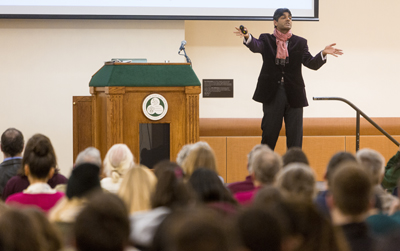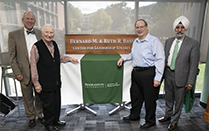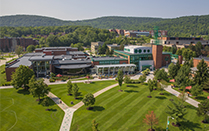
Fourth annual Research Days celebrated
Binghamton University’s fourth-annual Research Days were held April 22-24, featuring a keynote speech, student poster sessions, laboratory visits for area students and more. This year’s theme was sustainability.
“Research Days is a great opportunity to showcase the research that is being done at Binghamton University by faculty and students, and it also gives us a chance to focus on a topic that is very important to our campus and our community,” said Donald Loewen, vice provost for undergraduate education and chair of the organizing committee.
In addition to a keynote address by food activist and author Raj Patel, Research Days included two student poster presentations where undergraduate and graduate students from all academic disciplines showcased their research. More than 100 students participated this year, up from around 80 in 2014.
Binghamton faculty were invited to introduce students to their scholarly work during classes April 22-24, and several researchers opened their labs to area middle and high school students.
Patel’s talk, titled “Stuffed & Starved: The Hidden Battle for the World Food System,” kicked off the three-day celebration of research with a question: “What is the most important agricultural technology?”
Possible answers included the plow, fencing, the seed drill, inorganic fertilizer and genetically modified crops. While the audience seemed to veer toward inorganic fertilizer, Patel said fencing was the correct response “because it’s the reason we have the others.”
When lands were enclosed, “it was a way to pay debts,” he said. “You had the commons where peasants were able to share and manage resources together. To stint. To save. And they learned to hold off using something this year so they could use it the next year.”
Fencing allowed people to survive, he said. “The fencing made possible a way of enclosing the land and returning investments made into it to the owners. And it worked well for some.”
But others were not as fortunate. Land was appropriated as part of an expanding international agricultural system, Patel said, referring to slave rebellions and uprisings against large landowners in the 1700s as demonstrations of “inequality and what can happen when a poor country and rich city clash.”
Our modern food system can be traced to the land enclosures of the 1700s, Patel said. Exhibit A: a McDonalds ad promoting a burger for only $1. But when one considers the labor and the land that went into creating that burger, “all of a sudden a dollar burger has cost $200 to produce, yet we need cheap food.”
The modern food system is part of a cycle of cheap food, work, care, credit, nature and energy in which people are able to survive and work for a living. “The system keeps food prices and wages low, but breaking the cycle is not just about addressing food, it’s also about care.”
Those who can afford it pay for expensive food, but think about other parts of the world. “What about feeding the world?” he asked. “It’s a good and important question to bring to bear.”







